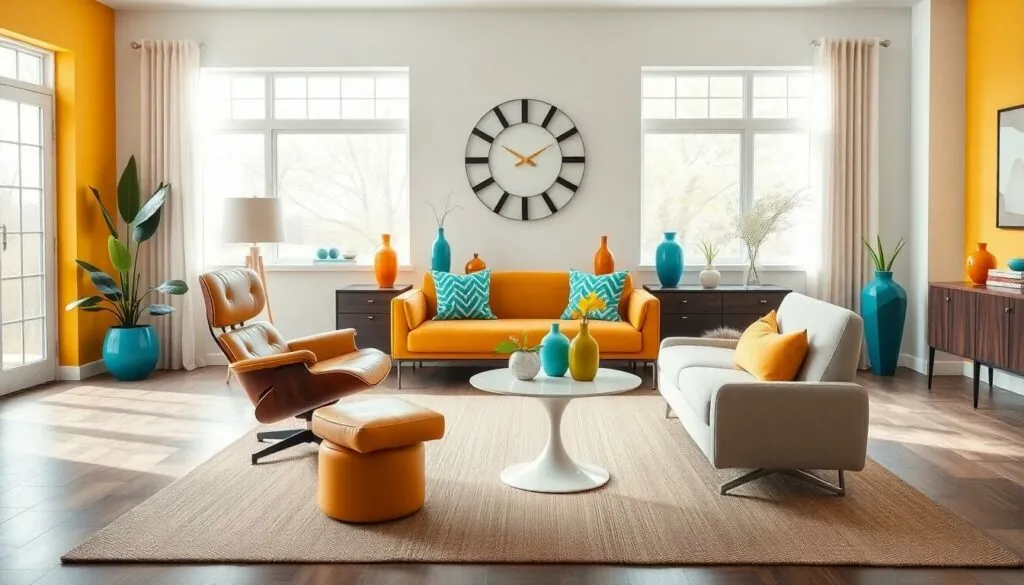Table of Contents
ToggleMid-century modern home decor isn’t just a style; it’s a way of life. Imagine stepping into a space where sleek lines meet playful colors, and every piece tells a story. This design movement, which flourished from the 1940s to the 1960s, has made a comeback, and it’s here to stay. With its timeless appeal, it invites anyone to channel their inner Mad Men character while sipping a martini on a stylish Eames chair.
Overview of Mid Century Modern Home Decor
Mid-century modern home decor emerged as a distinctive style between the 1940s and 1960s. This movement showcases simplicity, functionality, and organic forms. Clean lines, geometric shapes, and minimal ornamentation characterize the design, creating visually appealing interiors. Furniture often features natural materials like wood, with finishes emphasizing warmth.
Bold colors and patterns enhance the aesthetic, often inspired by nature. Shades of teal, mustard yellow, and olive green frequently appear in textiles, wall art, and accents. Large windows facilitate natural light, connecting indoor spaces with the outdoors. Functionality remains a priority, as many pieces serve dual purposes.
Iconic furniture pieces define this era, including designs by Charles and Ray Eames, Eero Saarinen, and George Nelson. Each designer contributed unique visions that still influence modern home decor. Accessories such as starburst clocks and abstract art further embody the mid-century vibe, enhancing the nostalgic feel.
Today, mid-century modern decor experiences a resurgence. Many homeowners embrace its timeless appeal, integrating classic elements with contemporary touches. Retailers offer a range of reproductions and inspired pieces, making this style accessible. Modern adaptations blend traditional mid-century aesthetics with today’s design trends.
Interior spaces reflect individual personalities through mid-century influences. Integrating various hues, textures, and styles creates dynamic environments. This decor style encourages a balance between comfort and elegance, appealing to those seeking unique yet functional living spaces.
Key Characteristics of Mid Century Modern Design

Mid-century modern design features distinct traits that set it apart from other styles. The focus on simplicity and elegance attracts many homeowners today.
Clean Lines and Minimalism
Clean lines define mid-century modern decor. Furniture showcases simple and geometric forms, avoiding excessive embellishments. Shapes tend to be uncluttered, contributing to a sophisticated aesthetic. Minimalism extends beyond furniture, influencing room layouts and accessory choices. Spaces often emphasize functionality without sacrificing style. Embracing negative space enhances the airy feel associated with this design approach.
Natural Materials and Textures
Natural materials play a crucial role in mid-century modern design. Wood, especially walnut and teak, forms the basis of iconic furniture pieces. Textures such as leather and linen contribute warmth and comfort to living spaces. Cultivating a connection to nature informs color palettes, which tend to feature earthy tones. Accessories often highlight organic shapes, reinforcing the theme of harmony with the environment. This appreciation for authenticity drives the charm of mid-century modern home decor.
Color Palettes in Mid Century Modern Decor
Mid-century modern decor features unique color palettes that enhance its distinctive style. Earthy tones harmonize with bold accents, creating a visual balance that attracts homeowners.
Earthy Tones and Bold Accents
Earthy tones dominate mid-century modern color schemes. Shades like olive green, burnt orange, and mustard yellow evoke a connection to nature. Bold accents in turquoise or deep blue often punctuate these palettes, adding vibrancy to the overall aesthetic. Furniture pieces frequently incorporate these colors, providing a striking contrast against natural wood finishes. Textiles also showcase rich hues, creating warmth and inviting living spaces. A careful mix of these tones establishes a cohesive look while celebrating the organic forms characteristic of this design style.
The Role of Lighting and Space
Lighting plays a pivotal role in enhancing mid-century modern aesthetics. Natural light floods spaces, highlighting clean lines and rich colors. Large windows create open areas that emphasize the airy feel of mid-century design. Pendant lights with geometric shapes often serve as focal points, further accentuating the decor’s unique elements. Thoughtful placement of furniture fosters a sense of flow, allowing different color zones to interact harmoniously. Accessories like floor lamps can complement bold colors while adding depth to the overall design scheme.
Essential Furniture Pieces
Essential furniture pieces define mid-century modern decor, contributing to its streamlined aesthetic and functional living. This style blends form and function effectively, showcasing timeless designs.
Iconic Mid Century Modern Furniture
Mid-century modern furniture includes several iconic pieces that embody simplicity and elegance. The Eames Lounge Chair is a prominent example; its molded plywood and leather create luxurious comfort. Saarinen’s Tulip Table also stands out with its sculptural pedestal base and sleek design. Another notable piece is the Noguchi Coffee Table, featuring a harmonious glass top and organic wooden base. Each design highlights clean lines, vibrant colors, and organic shapes, making them staples in modern homes.
Choosing the Right Pieces for Your Space
Selecting the right pieces for your space requires careful consideration of scale and palette. Start by measuring available space to ensure furniture fits without overcrowding. Prioritize functional items like multi-use sofas or extendable dining tables that accommodate gatherings. Consider incorporating a few statement pieces, such as a brightly colored chair or an eye-catching light fixture, to add personality. Ensure each selection aligns with the overall color scheme, emphasizing earth tones or bold accents. Thoughtful arrangements promote flow and create a cohesive and harmonious environment.
Tips for Styling Your Home
Incorporating mid-century modern decor in a home creates an inviting space that reflects a unique aesthetic and lifestyle.
Accessories to Complement the Look
Bold accessories enhance mid-century modern decor. Consider geometric-shaped vases and starburst wall art to add visual interest. Cushions featuring vibrant colors, such as mustard yellow or teal, can rejuvenate a neutral palette. Additionally, vintage pieces, like abstract sculptures, serve as conversation starters. When selecting rugs, choose those with simple patterns that won’t overwhelm the room. Layering elements provides depth, making the space feel more dynamic.
Balancing Functionality and Aesthetics
Functionality remains vital in mid-century modern interiors. Selecting multi-functional furniture, like ottomans with storage, maximizes utility without sacrificing style. Open layouts promote flow, allowing visitors to navigate comfortably. A combination of sleek coffee tables and minimalist shelving creates an organized look. Prioritizing natural light through large windows or strategically placed mirrors enhances the airy feel. Unique lighting fixtures, such as pendant lights, not only illuminate spaces but also act as focal points. Balancing these elements results in a harmonious environment that embraces both form and function.
Mid-century modern home decor continues to captivate those seeking a blend of nostalgia and contemporary style. Its emphasis on clean lines and organic forms creates spaces that feel both inviting and sophisticated. By incorporating iconic furniture pieces and bold color palettes, homeowners can effortlessly achieve a timeless aesthetic.
This design movement not only enhances the visual appeal of a home but also promotes a lifestyle centered around simplicity and functionality. As more people embrace this style, mid-century modern decor remains a relevant choice for creating harmonious living spaces that reflect individuality and comfort.



